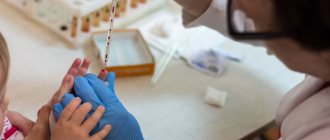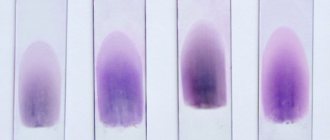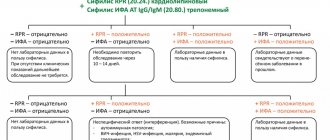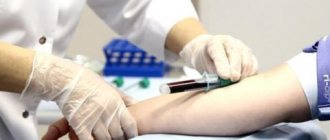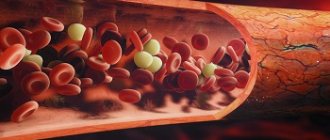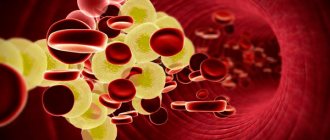Detailed description of the study
The balance of the action of the coagulation and anticoagulation systems of blood in the body (hemostasis) is maintained through many reactions and the complex interaction of proteins with each other. Against the background of severe illnesses, injuries and burns, surgical interventions and some other pathological conditions, disseminated internal coagulation syndrome (DIC syndrome) may develop.
In disseminated intravascular coagulation syndrome, hemostasis is impaired, and against the background of an increased tendency to bleeding, blood clots—thrombi—form in the vessels.
Normally, fibrin protein is an intermediate product formed when fibrinogen is destroyed by another protein, thrombin. These substances are one of the key blood clotting factors.
In intravascular coagulation disorders, thrombin levels are low and the amount of fibrin is insufficient to form a clot. Instead, it binds to fibrinogen or its breakdown products, resulting in the formation of soluble fibrin-monomer complexes (SFMCs). Thus, RFMKs are microthrombi found in the blood.
If the concentration of RFMC increases, this indicates an increased tendency of the body to form blood clots.
The formation of blood clots usually requires a combination of unfavorable factors, such as hereditary predisposition, decreased physical activity, and insufficient fluid intake.
One of the conditions in which there is a tendency to blood clots is pregnancy. The formation of microthrombi in a woman’s body can impair blood flow in the placenta and lead to pregnancy loss.
Determination of the RFMK indicator can be carried out to identify disseminated intravascular coagulation syndrome, the causes of thrombosis, their risk during pregnancy, as well as during heparin treatment. The test is used for indirect diagnosis of placental blood flow disorders; together with coagulogram indicators, it helps to identify impaired hemostasis.
Alpha1-acid glycopeptide (seromucoid)
Alpha 1-acid glycopeptide (AGP, seromucoid)
- is one of the main “acute phase” proteins. Serum concentrations can increase 3–4 times during inflammatory processes, infections, and malignant neoplasms. A dynamic study of AGP allows one to assess the course of the inflammatory process and diagnose relapse after surgical treatment of tumors. The analysis is used as a prognostic sign of the development of heart failure after myocardial infarction, as well as to detect hemolysis (together with haptoglobin).
Alpha1-acid glycopeptide (seromucoid) is part of the connective tissue of the body, and in case of its destruction or damage, they enter directly into the blood plasma.
Many pathological diseases cause changes in the level of seromucoids in the blood serum. When diagnosing slowly occurring inflammatory processes, the level of seromucoids is determined. So, an increase in this indicator indicates activation of the process, even if clinical symptoms have not yet appeared. Assessment of seromucoid levels is used to monitor the development of cancer, tuberculosis, and also when deciding on thyroidectomy - surgical removal of the thyroid gland.
AGP is synthesized mainly by liver parenchyma cells.
Like haptoglobin and prealbumin, its concentration increases in the presence of endogenous (eg, Cushing's syndrome) or exogenous (with treatment with prednisone or dexamethasone) glucocorticoids. Estrogens, nephrotic syndrome, and protein-losing enteropathy cause a decrease in plasma levels of alpha-1-acid glycopeptide.
Indications:
- monitoring the treatment of inflammatory processes;
- diagnosis of collagenosis (connective tissue diseases), tuberculosis infection;
- diagnosis of malignant tumors;
- diagnosis of relapses;
- diagnosis of hemolysis (together with haptoglobin).
Preparation
It is recommended to donate blood in the morning, between 8 am and 12 pm. Blood is drawn on an empty stomach or after 6–8 hours of fasting. It is allowed to drink water without gas and sugar. On the eve of the examination, food overload should be avoided. Do not smoke one hour before the test.
Interpretation of results
Reference values: 0.5–1.5 g/l.
Indicator increase:
- inflammatory processes (bacterial and viral infections, especially in newborns);
- Crohn's disease, myocardial infarction;
- rheumatic diseases;
- systemic lupus erythematosus and other autoimmune diseases;
- Itsenko-Cushing's disease;
- injuries, surgical interventions, tumor processes;
- inflammation of the vascular wall;
- Hodgkin's disease.
Decrease in indicator:
- early stages of pregnancy;
- severe liver damage (end stage of hepatocellular disease);
- nephrotic syndrome;
- gastroenteropathy with protein loss, fasting;
- taking medications - antimicrobials, cyclosporins, penicillamine, tamoxifen, oral contraceptives, estrogens.
Biochemical blood test (BAC) – by whom and when is it prescribed, how to prepare for the study
The first test that a therapist prescribes when complaining of deterioration in health is a biochemical blood test.
Also, all those undergoing preventive examinations and medical examinations are sent for examination. The blood test does not require much preparation. It is enough to follow the following rules:
- blood is donated in the morning, before meals;
- The day before the test, it is forbidden to drink alcohol and fatty foods. The night before the test, exclude sweets, strong tea and coffee from your diet;
- It is advisable to arrive 15 minutes before the blood draw, calm down and catch your breath.
You can take a biochemical test in Moscow at the Evermedic clinic. Our specialists will carefully and almost painlessly collect material from even the thinnest veins. The laboratory will produce the results of the biochemical analysis within 1 day - a table with the results can be picked up either in person or received by mail.
Below we will provide a breakdown of the analysis for adults, however, you need to understand that this information cannot be used for self-diagnosis and self-prescription of drugs. The interpretation of indicators and diagnosis should be carried out exclusively by the doctor, who makes a conclusion based on the medical history.
How does the analysis procedure work?
Venous blood is used to study the concentration of seromucoids. The material is collected in the morning, on an empty stomach. One day before the test, it is necessary to exclude the use of alcohol and medications (or inform the attending physician about their use), and 12 hours before - smoking. It is necessary to avoid physical and emotional stress the day before donating blood. Women should consult with their doctor in advance about choosing to donate blood, as their test results may be affected by the timing of their menstrual cycle.
It is contraindicated to be nervous on the day of the test. In addition, after donating blood, it is recommended to avoid physical activity and follow a moderate diet to quickly restore lost blood volume. If blood is to be donated to a child, parents need to ensure that the child is calm and not subjected to excessive physical activity.
The test is carried out by separating the blood serum and then analyzing the serum particles using a spectrophotometer or photometer. The principle of the analysis is that the serum particles of the substance absorb light in different ways. Both an increase and a decrease in the concentration of seromucoids may indicate unfavorable processes. An increase in concentration is caused by:
- various inflammatory conditions;
- Jaundice;
- rheumatism;
- pulmonary tuberculosis;
- exacerbation of chronic diseases, for example, cholecystitis;
- myocardial infarction and stroke.
A decrease in seromucoid concentration indicates that the liver does not synthesize protein sufficiently; this is an indicator of liver dystrophy, cirrhosis, hepatocellular and liver failure, alcoholic and viral hepatitis, or hepatocellular carcinoma. Low levels of albumin, seromucoid, prothrombin and protein in general are a reason to seriously check the liver.
Why get tested for seromucoids?
Indications for taking a blood test for seromucoid content most often include assumptions about connective tissue disease or systemic inflammation. The following pathological conditions can increase the number of seromucoids in the analysis:
- respiratory tract diseases - asthma, pneumonia, bronchitis, etc.;
- inflammatory processes in the kidneys - for example, glomerulonephritis;
- rheumatism;
- pancreatitis;
- cholecystitis;
- infertility caused by a chronic, sluggish process, for example, in the pelvic organs;
- lymphogranulomatosis;
- autoimmune diseases;
- tumor processes.
The analysis is carried out not only to make a diagnosis, but also to evaluate the effectiveness of treatment. During therapy, the concentration of seromucoids in the blood is assessed several times - and if it continues to exceed the norm, this means that the chosen treatment strategy is ineffective or the diagnosis is incorrect.
Seromucoid: what is it, reasons for the increase, treatment
Analysis for seromucoids is rarely used in medical practice, but in some cases it helps diagnose diseases.
Most often, the analysis is prescribed by such narrow specialists as therapists, cardiologists, pulmonologists and rheumatologists. In addition, total protein, C-reactive protein, rheumatoid factor, sialic acids and haptoglobin are usually examined.
Analysis for seromucoids is rarely used in medical practice, but in some cases it helps diagnose diseases.
An increase in seromucoids in the blood is not an independent disease. This is only a symptom of pathological processes occurring in the body, the etiology of which can be completely different. Therefore, there is no single medicine to normalize the level of seromucoids - it is necessary to establish the cause of the disease and purposefully treat it.
For example, for rheumatism, the patient is prescribed complex therapy consisting of antibiotics, immunomodulators, hormonal and anti-inflammatory drugs. Usually this treatment is effective and after completing the full course, the level of seromucoids decreases.
If the increase in seromucoids is caused by a malignant tumor, then the entire arsenal of anti-oncology drugs is used - chemotherapy, radiotherapy, and other methods of fighting cancer.
There is no prophylaxis against increased seromucoid levels as such. Often this condition is caused by diseases whose occurrence is genetically determined (asthma, rheumatism, cancer). Therefore, the only way to prevent it is to maintain a healthy lifestyle, which reduces the likelihood of such diseases.
Prevention of tuberculosis (which also results in an increase in the concentration of seromucoids) consists of timely vaccination, avoiding contact with infected people, and observing safety and hygiene rules when working in damp, dark, dirty rooms.
Interpretation of results
For children under 14 years of age, reference values are lower than for older patients. The production of ASL-O in the body begins 7-14 days after infection. After 1-1.5 months, its concentration reaches its maximum value. Antibodies can be detected in the blood for some time after recovery.
A low level of antibodies or their absence makes it possible to exclude with a high degree of probability a recent infection with streptococci. To confirm, the analysis can be repeated at intervals of about two weeks. If the result is negative again, there is most likely no infection. Exceptions to this rule are rare, but still occur. In rare cases, in patients with complications after infection, ASL-O levels remain within reference values.
Exceeding the norm by 4 or more times, as well as an increase in indicators, indicate a streptococcal infection that the patient recently suffered. A decrease in antibody concentration indicates recovery. The number of antibodies can be used to judge how long ago the infection was suffered. It is impossible to judge the likelihood of complications developing, as well as their possible severity, using ASL-O indicators alone. The test results can confirm the diagnosis in patients with symptoms of glomerulonephritis or rheumatic fever. A number of factors need to be taken into account when interpreting the results. Antibody levels may increase in patients with reactive arthritis, liver pathologies and hypercholesterolemia. When taking a number of antibacterial drugs, corticosteroids, as well as in patients with nephrotic syndrome, false negative results may be obtained. This test is not used to diagnose acute infection, since ASL-O is detected no earlier than 1-2 weeks after infection.
Indications for the study
Analysis is prescribed in the following cases:
- The appearance of health complaints soon after a sore throat or skin lesion, if there is reason to believe that the cause of their appearance is a previous streptococcal infection. Usually the test is prescribed 2-3 weeks after the illness. The value of the test increases significantly if it is performed several times at intervals of about 2 weeks. In this case, the dynamics of the results makes it possible to most reliably assess the patient’s condition.
- Treatment of complications of streptococcal infection. The analysis is prescribed by the doctor 7-14 days after the start of treatment in order to assess its effectiveness and, if necessary, adjust the previously prescribed therapy.
Interpretation of biochemical analysis in adults
A biochemical blood test contains 9 main indicators:
- Glucose. Displays the amount of sugar in the blood. Normally, the glucose level is from 3.5 to 6 - these numbers in the analysis indicate that the body absorbs it without problems. If your fasting glucose level is 6.5 or higher, then you should consult a doctor as soon as possible - there is a risk of diabetes.
- Total cholesterol. This indicator should normally not exceed 5.2. High cholesterol indicates a risk of atherosclerotic vascular disease, angina pectoris and heart disease.
- Total bilirubin. The normal indicator is from 5 to 21 for an adult; the indicators for newborns differ significantly. An increased value of total bilirubin indicates problems with the liver: pathologies may include hepatitis and diseases of the biliary tract.
- Transaminases. The doctor pays attention not to the number of different transaminases, but to their proportional ratio.
- Total protein. Its norms for adults range from 65 to 85 g/l. The level of protein in plasma can tell the doctor about problems in the kidneys, liver, pancreas, and also identify disorders of protein, lipid and carbohydrate metabolism.
- Urea and creatinine. These two indicators reflect the functioning of the kidneys. The norm for urea is 2.2 - 7.3 mmol / l, the level of creatinine greatly depends on the weight and physical activity of the patient.
- Iron. The norm for this element is 12.5-32.3 µmol/l for men and 0.7-32.3 µmol/l for women. It is better to check your iron as often as possible, since without a sufficient amount of hemoglobin the body cannot function fully.
- C-reactive protein - this protein begins to be synthesized by the liver at the beginning of the inflammatory process. Therefore, its presence in the blood indicates the presence of the disease.
- Uric acid. Its norm is up to 428 µmol/l; exceeding this level is dangerous due to the appearance of arthritis and gout.
